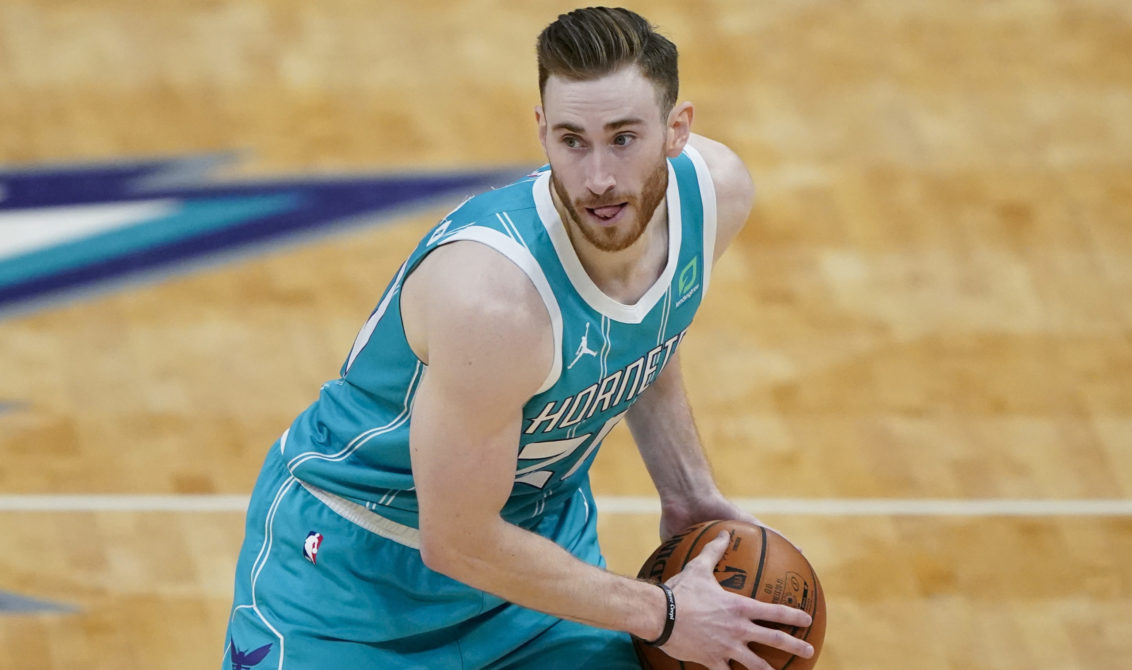January 22, 2021
Photo: AP Photo / Chris Carlson
When the Charlotte Hornets signed Gordon Hayward to a four-year, $120 million contract– a move that arguably made the biggest splash of the NBA offseason– the reaction was polarizing. Some fans and national media members saw it as a perfect segue for a rebuilding team that would eventually hand the keys to the franchise over to LaMelo Ball, while others saw it as a potential repeat of the Nicolas Batum contract situation. Fourteen games into Hayward’s deal, and the former seems to be much more likely than the latter.
Let’s get this out of the way: Is $30 million per year for a borderline All-Star an overpay? Probably, but there are a few reasons that it really doesn’t matter, the most obvious being that an NBA team located in a smaller market rarely gets a high-level player for fair market value– which is no slight to Charlotte, it’s just reality for the time being. Another reason is that we’ve seen Chris Paul, Russell Westbrook, and John Wall (all of whom had bloated contracts) get traded in the last calendar year, so nobody can say that 34-year-old Hayward would be an “untradable” contract in 2024. Lastly, Michael Jordan is paying Hayward that $30 million per year. Not the fans. It won’t send the Hornets flying over the salary cap in the future, so the bottom line is basically: Who cares if he’s getting paid a lot? He’s been a really good player.
👌 triples for @gordonhayward#AllFly | @HornetsOnFSSE pic.twitter.com/RytJlX1ZqV
— Charlotte Hornets (@hornets) January 7, 2021
It was expected that Hayward would become a leader and the team’s best player, but the degree to which he’s seamlessly fit in with the rest of the roster is impressive, and it speaks to how team-friendly his game is. Hayward’s per-game averages of 22.2 points, 5.7 rebounds, 3.7 assists and 1.2 steals all land in the top-four among Hornets players, and he’s doing it on wildly efficient 49.3/40.9/93.1 shooting splits.
There’s an outside chance Hayward enters the renowned 50/40/90 Club this season, which consists of just eight players in NBA history: Larry Bird, Stephen Curry, Kevin Durant, Steve Nash, Dirk Nowitzki, Reggie Miller, Mark Price, and Malcolm Brogdon. Ever heard of them?
His 61.1 true shooting percentage is a career high and a 24.9 usage percentage is the highest it’s been since the 2015-2016 season. This version of Hayward is closer to his All-Star form from his Utah days more so than his years in Boston. When the Hornets offense is sputtering– as they have often this season– Hayward can be relied upon to slow things down and get a bucket. The craft he uses to pick his spots on the floor and get defenders off balance is elite, which has helped his free-throw generation metrics rebound from his time with the Celtics.
.@gordonhayward is feeling it! 🔥#AllFly | @HornetsOnFSSE pic.twitter.com/upgLjGL2Cf
— Charlotte Hornets (@hornets) December 13, 2020
Hayward has always been a master of the “in-between” game, leveraging his footwork, his coordination, and basketball IQ to make a living in the toughest/least efficient area on the court. According to Cleaning The Glass, Hayward is in the 88th percentile (52 percent) on “long mid-range” shots, which is qualified as a shot that is further than 14 feet from the basket, but inside the 3-point line, and 73rd percentile (46 percent) on all mid-range shots. His shot diet (84th percentile in mid-range field goal attempts) is a direct contradiction from the three-pointers and layups that Borrego preaches, but Hayward gets buckets, so Borrego really has no choice if he wants the team to succeed.
Hayward’s passing and defense also often get overlooked because of his scoring efficiency. His 1.6 steal and his 18.7 assist percentages are in the 84th percentile, per Cleaning The Glass. The Hornets needed more ball handlers to take some pressure off of Devonte’ Graham and allow him to hunt for spot-up threes off-ball more often, and Hayward’s steadiness, reliability, and willingness to involve his teammates and defer to the hot hand are an ideal fit for this offense.
Nice dish by @Gordonhayward to @Bismackbiyombo!#AllFly | @HornetsOnFSSE pic.twitter.com/mVjtqKI97A
— Charlotte Hornets (@hornets) January 17, 2021
Charlotte’s starting lineup has one of the worst point differentials of any starting group in the league, but that is not the fault of Hayward, or even Graham, Terry Rozier or PJ Washington. When Bismack Biyombo is replaced with Miles Bridges, the Hornets outscore teams at an extremely high rate. On any given night, Hayward can be the No. 1 scorer that buoys the Hornets’ offense while the youngsters go through slumps, a two-way hybrid wing/forward, or a 6’7” point guard whose sole mission is to get his teammates going. Graham has been getting more open catch-and-shoot looks from beyond the arc, and Rozier has proven himself to be one of the league’s elite long-range shooters, but without Hayward demanding attention from defenses, those two are not able to get free for open looks as often as they have this season.
NBA basketball games are won and lost with talented wing scorers, and the Hornets needed one. Hayward has filled that void so far, morphing into a point forward or off-ball cutter on any possession, and it has been invaluable to their offense. The Hornets’ team assist percentage is 73.6, meaning nearly three-quarters of their buckets come off of assists. Hayward’s “glue guy” style of play combined with his sheer talent on the perimeter is a big reason why, and the result is a Charlotte team that is taking steps in their progression while playing some fun, exciting, team-oriented basketball in the meantime.
So good you have to see it again… from a different angle 🎥 @Gordonhayward | #AllFly pic.twitter.com/ORXN0ZBOZd
— Charlotte Hornets (@hornets) January 12, 2021
.@gordonhayward from DEEP 👌#AllFly | @HornetsOnFSSE pic.twitter.com/FQzBnCPKsS
— Charlotte Hornets (@hornets) January 9, 2021
Read next:

 By
By 
